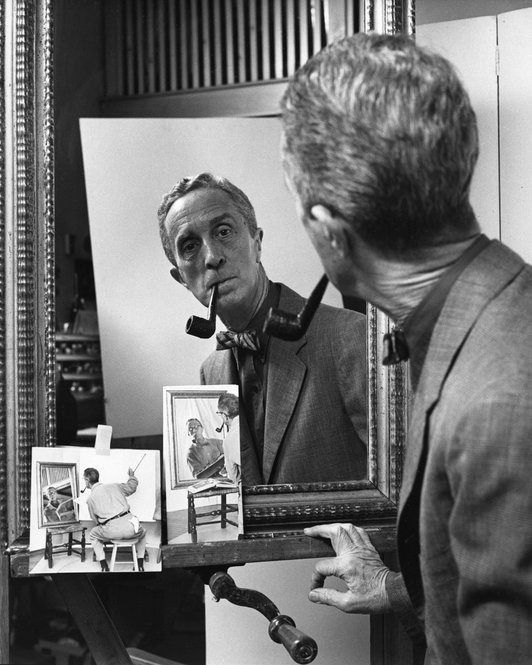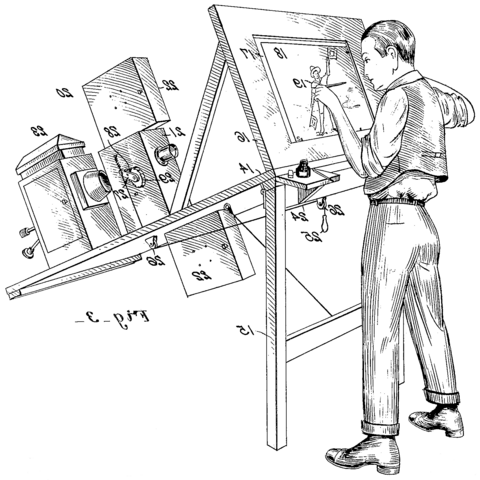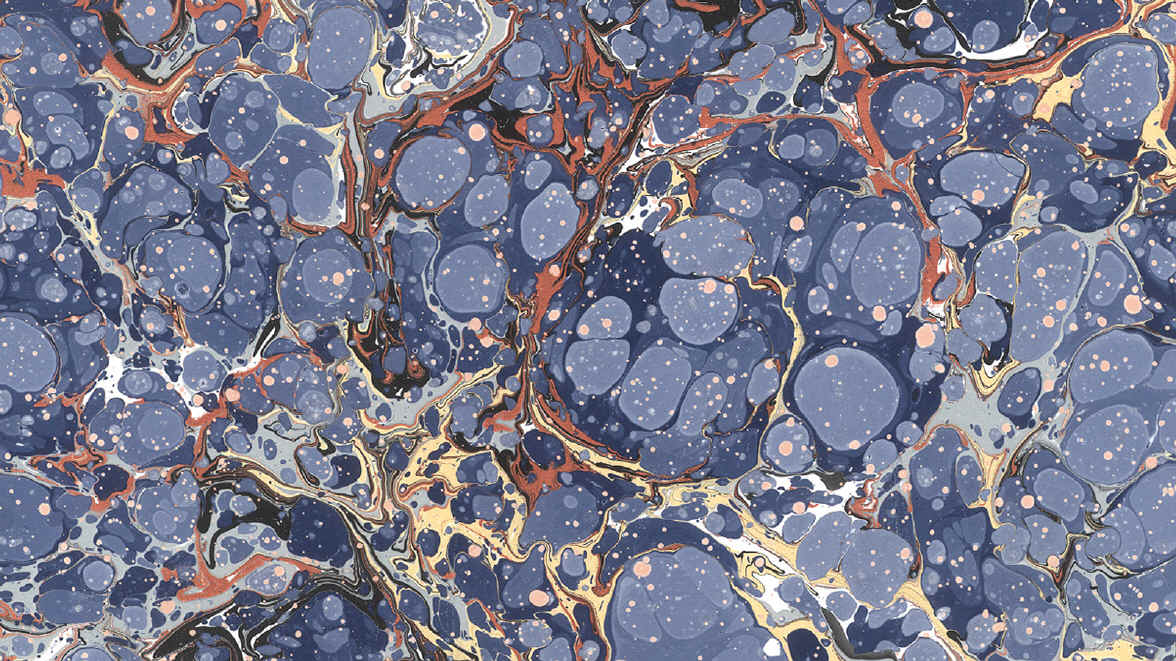If you are an artist working in these processes, or an historian itching to tell us more about one of these, or about one not listed here, please email us.
We are very interested in more information about this – titbits or thesises, anything you want to share!
Abration tone
William Mortensen’s abrasion tone has much in common with other forgotten processes in that the materials needed are no longer as common as they once were, especially projection papers such as the former Eastman Kodak Projection Proof. This had a surface that accepted razor blade etching, pencil work and pumice work. It was also great for oils, I worked out a simple version of mediobrome that I was pleased with.
– comment from Norm
Allotype
See Amphitype.
Amphitype
Starting in the 1850s, as an alternative term for collodion direct positives (ambrotypes). Suggested to Herschel by Talbot, instead of Herschel’s initial Celanotype, or Allotype.
Argentotype
Invented by Sir John Herschel, like many other processes. Iron salts (ferric citrate) are used to precipitate silver under the influence of UV-light. The print is developed in silver nitrate. This process was later modified to become what is now the more known Kallitype and Vandyke process.
Atrephograph
The Atrephograph was invented by James M. Letts.
Aurotype
Part of the Siderotype family. Siderotypes are processes using iron.
Autochrome
1904 in France. Auguste and Louis Luminere inveted the Autochrome process. A glass plate was dusted with microscopic grains of potato startch that had been dyed red-orange, green and blue-violet. Any spaces were then filled in with a powder of black carbon. A panchromatic emulsion was then applied to the plate. The plate then exposed and developed, exposed, developed, exposed and re-developed again, forming a postitive transparency. In the 30s more sophisticated film became available and the Autochrome process died out.
Breath print
Part of the Siderotype family. Siderotypes are processes using iron.
Brown line
Part of the Siderotype family. Siderotypes are processes using iron.
Calotype
Introduced in 1841 by Fox Talbot and used for about 10 years after. A weak salt solution was used, the paper dried, then brushed with a weak silver nitrate solution. This made a silver chloride on the paper and was light sensitive. The final image was fixed using a salt solution called potassium iodide of hypo.
Catalisotype
This process used hydrochloric acid, syrup of ioduret of iron, iodine and nitrate of silver.
Celanotype
See Amphitype.
Chlorophyll prints
Binh Dahns photosynthesis process. Binh says:
One summer, I was motivated to experiment with photosynthesis and its pigments after watching the lawn change color due to a water hose that was placed on it. Soon after that observation, I was making chlorophyll prints. Photosynthesis takes place in plants as carbon dioxide, water, and light energy is converted to sugars and oxygen. Photosynthesis is the main route by which free energy in the environment is made available to the living world. In my work, photosynthesis is used to record images onto leaves. The leaves are then cast in resin, like biological samples for scientific studies. The images were made into negatives. Then exposed onto living leaves, by placing the negatives onto the leaf, and placing that into a contact printing frame. The image formation was all due to chlorophyll, light, carbon dioxide, and water: the life source of plants and, consequently the Earth. This process deals with the idea of elemental transmigration: the decomposition and composition of matter into other forms.
Chromotype
Coat paper with a sulphate of copper and bichromate of potash solution and expse it to sunshine, then apply a solution of silver nitrate.
Cyanotype Rex
Terry King and Michael Maunder have done some experiments with Cyanotypes, going back to it’s source. Reading the original paper Writer / Sir John Herschel in 1842 – available at the Royal Society in London – lead to a “retro-invention” of the cyanotype process. King calls this invention “Cyanotype Rex” and Maunder’s take on the process is called “Herschelotype”. According to an article in View Camera, November 2005, the Cyanotype Rex has much shorter exposure times than the other recipes and tones well.
Ferro-gallic process
1861 Alphonse Louis Poitevin, french chemist. Found the reduction and conversion of ferric salts to a ferrous state when exposed to UV-light. A graphic technique, producing very black images. Gum arabic + water + ferric chloride + ferric sulphate + tartaric acid. The mix is applied, dried and contact printed in UV-light, then developed in gallic acid, potash alum and hydrochroric acid, washed and dried.
Ferro-tannic process
Iron salts (ferrous sulfate) turn black when exposed to tannic acid, potassium dichromate and water mixed, paper was coated and dried, then exposed in contact frame and washed. Toned in tannic acid to create a black print.
Ferrotype
Originally called Energiatype. The process uses proto-sulphate of iron as a reducing agent. Same as Tintype.
Fluorotype
Paper is washed with bromide of potassium and with fluate of soda.
Herschelotype
A variation on Cyanotype Rex by Michael Maunder.
Ivorytype / Hellenotype
A picture produced by superposing a very light print, rendered translucent by varnish, and tinted upon the back, upon a stronger print, so as to give the effect of a photograph in natural colors.
Kelaenotype
Part of the Siderotype family. Siderotypes are processes using iron.
Kwik-Print
Kwik-Print was a late-’70s technique involving coating a plastic
receptor sheet with light-sensitive dyes. You washed off the unexposed areas and could re-coat the sheet with another color. Bea Nettles was its most renowned practitioner and she has published Breaking the Rules: A Photo Media Cookbook. Tom says: “I’m sure Kwik-Print is long gone but I had fun with it”.
– contributed by Tom Nelson
Nakahara’s process
Part of the Siderotype family. Siderotypes are processes using iron.
Orotones
Traditionally called orotones, goldtones, or Curt-tones, the images would have been made by printing a positive image onto a sheet of glass coated with a photosensitive emulsion. The image on the glass was then backed with a mixture of banana oils and gold bronzing powder.
23.5K gold powder is what I’ve added in exchange of the bronzing powder. The process of coating glass sheets with photographic emulsion, printing and processing the image and coating it with gold, is all done by hand.
Edward Curtis, photographer of the American Indians and one who perfected the orotone (he called them Curt-Tones), is quoted as saying this of the process:
“The Ordinary Photographic print, however good, lacks depth and transparency, or more strictly speaking, Translucency. We all know how beautiful are the stones and pebbles in the limpid brook of the forest. Where the water absorbs the blue of the sky and the green of the foliage, yet when we take the same iridescent pebbles from the water and dry them they are dull and lifeless, so it is with the ordinary photographic print, but in the Curt-Tones (orotone) all the transparency is retained and they are full of life and sparkle as an opal.”
– contributed by Ryan Zoghlin, photograph by Ryan Zoghlin
Pannotypes
Pannotypes are large format tintypes exposed on tissue or wood, often handcolored. An old “folk-art tradition”, especially in the USA.
Pellet print
Part of the Siderotype family. Siderotypes are processes using iron.
Phipson’s process
Part of the Siderotype family. Siderotypes are processes using iron.
Photoceramics
From Harry L Burnett Jr:
I have been working with photoceramics since mid 1950s. My first efforts were with toned wet collodion positives. Later I worked with light sensitive diazo compounds for a while. After retirement, I began to work with the dichromate dust-on process. This was productive and very informative. Images could be produced that held exqusite detail and were probably as permanent as any continous tone print process ever discovered, very time consuming and difficult to achieve consistant results. About 2-3 years ago I began an odyssey with digital printing hoping to make film positives that would give me better control of the dust-on process. I mixed digital inks that were useful and it evolved into a simple useful photoceramic process.
I am now able to digitally fuse metallic oxide images onto ceramic substraits at 1250 degrees F. with a resolution of 2880×720 spots per inch in monochrome colors.
Pizzitype
Captain Giuseppe Pizzighelli’s (1849-1912) Pizzitype paper (similar to Ziatype) was manufactured a short time and a commercial success until technical problems stopped the production.
Platinograph
Another name for, and the same as, the Kallitype process.
Polychrome
Another name for, and the same as, the Kallitype process.
Pontontype
Mongo Ponton (1801-1880), Scottish inventor. 1839 discovered that postassium bichromate was sensitive to light. He called his discovery Pontontype. A handome print that unfortunately faded with few months. But, this discovery was the beginning of gum bichromates! Thank you Ponton!
Rawlins process
From Philippe Berger:
G.E.H. Rawlins invented in 1904 a process by which a layer of bichromated gelatine was exposed to light under a negative.
The tanning of the gelatine is in direct proportion to the transparency of the negative. Shadow areas are strongly tanned, mid-tones less so and highlights are not tanned at all.
After development it is washed to produce an image with a very subtle relief. Using oily pigments, either in monochrome or colour, the original image is then restored by hand. The ink is absorbed by the tanned part of the image but is repelled by the water held in the soft, untanned areas.
This inking process with a brush is the adaptation of Rawlins at this process.
Philippe has also written a book on the process Le Procédé Rawlins à l’Huile, in french. More details of this book can be found on Philippe’s website.
The Rawlins process is the same as the oilprint process.
Satista
Another name for, and the same as, the Kallitype process.
Satista is an economical hybrid of platinum and silver. This process was created when the price of platinum was high.
It’s an economic way to produce images which look like platinum and are in between silver and platinum.Some people think that some of Stieglitz prints named platinum were Satista prints.
– comment from Ayral Philippe
Sensitol
Another name for, and the same as, the Kallitype process.
Sepiatype
Part of the Siderotype family. Siderotypes are processes using iron.
Siderotype
Siderotype covers all the iron-based processes – cyanotype, platinotype, chrysotype, etc. – it was used first by Herschel and comes from the Greek root word ‘sideros’, meaning ‘iron’. Siderotype therefor means any ‘iron-type’ print.
Soline
Another name for, and the same as, the Kallitype process.
Sphereotypes
Sphereotypes is a process patented (US patent #14,696 I believe) by Albert Bisbee in 1856. It was essentially a positive collodion image on glass that was exposed through a spherical mask – hence the name sphereotype – which was the same size as the mount that was to enclose it or case it was to be put into.
Talbotype
See ‘Calotype’.
Woodburytype
WB Woodbury (1834-85) invented this process, claiming it would not fade. Successfully. The do not fade, because the images do not rely on light-sensitive materials, but are made up of a stable pigment suspended in gelatine.



